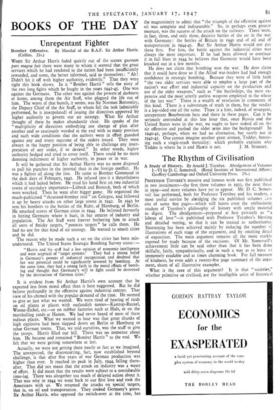The Rhythm of Civilisation
A Study of History. By Arnold J. Toynbee. Abridgement of Volumes 1—VI by D. C. Somervell. (Royal Institute of International Affairs : Geoffrey Cumberlege and Oxford University Press. 25s.) PROFESSOR TOYNBEE'S massive and famous work was first published in two instalments—the first three volumes in 1933, the next three in 1939—and more volumes have yet to appear. Mr. D. C. Somer- vell has performed, both for Professor Toynbee and his readers, a most useful service by abridging the six published volumes :aro one of some 600 pages—which still leaves even the enthusiastic student of Toynbee's philosophy of history with ample material to digest. The abridgement—prepared at first privately as "a labour of love "—is published with Professor Toynbee's blessing and detailed vetting, so that it can be treated as authoritative. Shortening has been achieved mainly by reducing the number of illustrations of each stage of the argument, and by omitting detail of exposition. The main argument remains all the more starkly exposed for study because of the excisions. Of Mr. Somervell's achievement little can be said other than that it has been done skilfully, fairly, sympathetically, and in such a way as to leave -ta immensely readable and at times charming book. For full measure of kindness, he even adds a twenty-five page summary of the argu- ment, shorn of all illustrative examples.
What is the core of this argument? It is that "societies," whether primitive or civilised, are the intelligible units of historical study, and not nations, or periods, or continents. The first three folumes are concerned with the genesis and growth of civilisations in the past ; the second three with the breakdown arid disintegration eif, civilisations. The clue to both processes, rise and fall, is found mainly in the operations of laws of "challenge and response." Much of the work is devoted to refining these two conceptions, and to demonstrating by historical examples how the process has worked in the past. It is even more difficult than after reading the original Work to escape the suspicion that many of the author's contentions, stripped of their refinements, are basically tautologous. Civilisations thrive when they successfully overcome material and spiritual chal- lenges to their growth, and decline when they are overcome by such challenges ; they decline because they are_already in decline ; they usually die of "suicide," if only in the sense that they die because they are already dying. As if conscious of this danger, the atithor in his final chapters strives to find a rhythm of disintegration mmon to all civilisations, to the tune of rout-rally-rout-rally-rout-
ly-rout, so that the heart of a civilisation beats three-and-a-hatf tithes before it expires. This strained conclusion is, so far' the ri*ost positive suggestion which the author has elicited from his vast Airvey. He is careful to insist that there is nothing inevitable about this rhythm, or about the decline of any civilisation, including our Own. On the contrary, he regards the essence of "response" as a spiritual and moral quality. It is perhaps unfair, however, to demand that he should forestall the conclusions of the remaining eight stage:, of his argument which have still to be written.
A more serious criticism of the work is that civilisations are judged primarily in terms of their survival-value and longevity, and hardly at all in terms of their quality or the height of their achievement. Nor, although the development in time of each separate civilisation is considered, does the time-factor of the whole consecutive historical process come under consideration. Both problems are shelved by the somewhat specious argument (p. 42-3) that civilisations are ",philosophically equivalent" and "philosophically contemporane- ohs." Is " philosophically " a new synonym for "Pickwickian"? It may be hoped that Professor Toynbee will tackle these issues more Seriously in later volumes.
Of minor matters, there are many separate judgements which sbem distorted, and the distortion is not always due to abridge- ment. Were the Austrians "harder hit" by the Paris settlement of 2918 than the Hungarians (p. 120)? Is there any sense in which Rousseau was a " cause " of the French Revolution and the sub- sequent wars (p. 507)? The dangers of such schematic thinking as is implicit in the whale approach sometimes lead to an exaggeration ; such as the interpretation of Machiavelli (p. 230), who appears oddly in the same list as Saint Paul, Saint Gregory, Buddha and Muhammad. The word "proletariat," as loosely used by the author, hardly expresses his exact meaning. The Habsburgs are still erroneously spelt " Hapsburgs " throughout. Personal and political prejudice creeps in when Abyssinia (p. 103) and Soviet Russia (p. 205) are discussed. It is a Pay that these and kindred blemishes have survived into the new edition. But whatever reservations and criticisms may be made, the work remains, even in abridgement, a remarkable tour de force. If it has lost in virtuosity it has gained
in digestibility, and, if depth of grasp is not always equal to width of sweep, it is still stimulating, persuasive and in many ways etv- trancing to read. It is altogether excellent that a wider and less courageous public will now be induced to read it.
DAVID THOMSON.



































 Previous page
Previous page